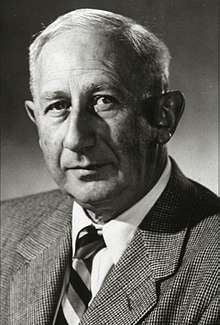Walter Baade
Wilhelm Heinrich Walter Baade (March 24, 1893 – June 25, 1960) was a German astronomer who worked in the United States from 1931 to 1959.
Walter Baade | |
|---|---|
 | |
| Born | March 24, 1893 |
| Died | June 25, 1960 (aged 67) |
| Nationality | German |
| Citizenship | German |
| Alma mater | University of Göttingen |
| Known for | Coined the term "supernova" and "neutron star" with Fritz Zwicky |
| Awards | Bruce Medal 1955 |
| Scientific career | |
| Fields | Astronomy |
| Institutions | Hamburg-Bergedorf Observatory, Mt. Wilson, Palomar Observatory |
| Doctoral students | Halton Arp Allan Sandage |
Biography
Son of a teacher, Baade finished school in 1912. He then studied maths, physics and astronomy at the universities of Münster and Göttingen. After receiving his PhD in 1919, Baade worked at Hamburg Observatory at Bergedorf from 1919 to 1931.[1] There in 1920 he discovered 944 Hidalgo, the first of a class of minor planets now called Centaurs which cross the orbits of giant planets.
He worked at Mount Wilson Observatory from 1931 to 1958.[2] There, during World War II, he took advantage of wartime blackout conditions (which reduced light pollution), to resolve stars in the center of the Andromeda Galaxy for the first time. These observations led him to define distinct "populations" for stars (Population I and Population II). The same observations led him to discover that there are two types of Cepheid variable stars. Using this discovery he recalculated the size of the known universe, doubling the previous calculation made by Hubble in 1929.[3][4][5] He announced this finding to considerable astonishment at the 1952 meeting of the International Astronomical Union in Rome.
Together with Fritz Zwicky, he identified supernovae as a new category of astronomical objects.[6][7] Zwicky and he also proposed the existence of neutron stars, and suggested supernovae might create them.[8]
Beginning in 1952, he and Rudolph Minkowski identified the optical counterparts of various radio sources,[9] including Cygnus A. He discovered 10 asteroids, including 944 Hidalgo, which has a long orbital period, and the Apollo-class 1566 Icarus, the perihelion of which is closer than that of Mercury, and the Amor-type 1036 Ganymed.
Honors
| 930 Westphalia | March 10, 1920 |
| 934 Thüringia | August 15, 1920 |
| 944 Hidalgo | October 31, 1920 |
| 966 Muschi | November 9, 1921 |
| 967 Helionape | November 9, 1921 |
| 1036 Ganymed | October 23, 1924 |
| 1103 Sequoia | November 9, 1928 |
| 1566 Icarus | June 27, 1949 |
| 5656 Oldfield | October 8, 1920 |
| 7448 Pöllath | January 14, 1948 |
Awards
- Foreign membership of the Royal Netherlands Academy of Arts and Sciences (1953)[11]
- Gold Medal of the Royal Astronomical Society (1954)
- Bruce Medal (1955)
- Henry Norris Russell Lectureship of the American Astronomical Society (1958)
Named after him
- Asteroid 1501 Baade
- The crater Baade on the Moon
- Vallis Baade, a vallis (valley) on the Moon
- One of the two Magellan telescopes
- The asteroid 966 Muschi, after his wife's nickname
See also
- Baade's Window, an observational area he identified in the 1940s as being relatively free of dust that presents a view of the Galactic Center in Sagittarius
- Baade's Star, now known as the Crab Pulsar, was first identified as being directly associated with the Crab Nebula by him.
References
- Osterbrock, D. E. (Sep 2002). "Walter Baade, Dynamical Astronomer at Goettingen, Hamburg, Mount Wilson, and Palomar Observatories". Aas/Division of Dynamical Astronomy Meeting #33. Harvard Univ. 33: 10.03. Bibcode:2002DDA....33.1003O.
- "1955 Brude Medalist". Sonoma State University. Retrieved 4 March 2016.
- Baade W (1944) The resolution of Messier 32, NGC 205, and the central region of the Andromeda nebula. ApJ 100 137-146
- Baade W (1956) The period-luminosity relation of the Cepheids. PASP 68 5-16
- Allen, Nick. "Section 2: The Great Debate and the Great Mistake: Shapley, Hubble, Baade". The Cepheid Distance Scale: A History. Archived from the original on Dec 10, 2007.
- W. Baade, F. Zwicky, 1934, "On Super-Novae". Proceedings of the National Academy of Sciences of the United States of America, 254-259.
- Donald E. Osterbrock, Walter Baade – A Life in Astrophysics, Princeton und Oxford: Princeton University Press 2001. ISBN 0-691-04936-X.
- Osterbrock, D. E. (2001). "Who Really Coined the Word Supernova? Who First Predicted Neutron Stars?". Bulletin of the American Astronomical Society. 33: 1330. Bibcode:2001AAS...199.1501O.
- Baade, W. and Minkowski, R., 1954. Identification of the Radio Sources in Cassiopeia, Cygnus A, and Puppis A. Astrophysical Journal, Vol. 119, p. 206-214 (January 1954) ADS: 1954ApJ...119..206B
- "Minor Planet Discoverers (by number)". Minor Planet Center. 4 September 2016. Retrieved 7 September 2016.
- "Walter H.W. Baade (1893 - 1960)". Royal Netherlands Academy of Arts and Sciences. Retrieved 26 January 2016.
Further reading
- Osterbrock, Donald E (2001-10-14). Walter Baade: A Life in Astrophysics. ISBN 0-691-04936-X.
- Dieke, Sally H. (1970). "Baade, Wilhelm Heinrich Walter". Dictionary of Scientific Biography. 1. New York: Charles Scribner's Sons. pp. 352–354. ISBN 0-684-10114-9.
External links
Obituaries
- AN 285 (1960) 286 (one sentence, in German)
- JRASC 55 (1961) 113
- MitAG 14 (1961) 5
- Obs 80 (1960) 166 (one sentence)
- PASP 72 (1960) 434 (one paragraph)
- QJRAS 2 (1961) 118